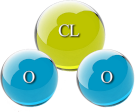Decontamination with chlorine dioxide
Effective Decontamination Method Using Chlorine Dioxide to Combat Multidrug-Resistant Acinetobacter Infections
By Andreas Kalcker
In a groundbreaking study conducted at Centro Médico Jurica in Querétaro, México, researchers have demonstrated the effectiveness of chlorine dioxide (ClO2) as a decontamination agent in hospital rooms previously occupied by patients colonized with multidrug-resistant Acinetobacter. The findings highlight an urgent solution to combat nosocomial infections, which pose significant risks in healthcare settings.
The contamination of hospital surfaces by patients colonized with Acinetobacter poses a significant risk for nosocomial infections. This issue highlights the urgent need to prevent the transmission and spread of these pathogens within healthcare facilities. In response, hospitals are adopting effective decontamination strategies using approved agents that have high biocidal capacity while maintaining low toxicity levels.
Highly Effective Decontamination
In a recent study conducted at a hospital, the safety and efficacy of Chlorine Dioxide (ClO2) as a decontaminant were evaluated. The process involved treating unoccupied inpatient rooms with ClO2 at a concentration of 60 parts per million (ppm) for a duration of 30 minutes. This was monitored in real-time using antimicrobial culture and ATP bioluminescence assays, which are reliable methods for assessing microbial contamination.
Following the decontamination process, surfaces previously occupied by patients colonized with Acinetobacter were sampled. Remarkably, no viable culturable spores or metabolic activity were detected on these surfaces.
The follow-up assessments revealed promising results: previous and subsequent patients did not develop Acinetobacter infections, and no signs of microbiological contamination were observed after the room decontamination process. These findings suggest that ClO2 is not only effective in eliminating harmful pathogens but also safe for use in hospital settings.
The results from this study indicate that Chlorine Dioxide can serve as a safe and economical antimicrobial agent, making it a feasible option for integration into medical practices. Its ability to significantly reduce the risk of infection transmission highlights its potential as a critical tool in maintaining hospital safety and protecting patient health. As healthcare facilities continue to seek innovative solutions to combat hospital-acquired infections, ClO2 stands out as a valuable asset in infection control strategies.
Study Overview
The research, led by Manuel Aparicio-Alonso, Alma Guadalupe Avalos-Contreras, and Verónica Torres-Solórzano, focused on monitoring the decontamination process using ClO2 at a concentration of 60 parts per million (ppm) for 30 minutes in unoccupied inpatient rooms. The necessity for effective decontamination methods arises from the persistent threat of Acinetobacter colonization, known for its resistance to multiple antibiotics, making it a formidable challenge in hospitals.
Methodology
The study employed real-time documentation to assess the safety and efficacy of the decontamination process. Key techniques included antimicrobial culture and ATP bioluminescence assays, which measure microbial contamination levels on surfaces. Before and after the application of ClO2, samples were taken from various surfaces within the rooms.
Results
Remarkably, after decontamination, there were no viable culturable spores or signs of metabolic activity detected on the surfaces. Follow-up assessments revealed that no patients who occupied the rooms post-decontamination developed Acinetobacter infections. Additionally, no microbiological contamination was observed after the ClO2 treatment, further underscoring its effectiveness.
Implications for Medical Practice
These promising results suggest that chlorine dioxide is not only a safe and economical option for decontaminating hospital environments but also feasible for integration into standard medical practices. With the ongoing threat of multidrug-resistant infections, this study provides critical insights into effective infection control measures that can enhance patient safety.
Conclusion
The implementation of chlorine dioxide as a decontamination agent represents a significant advancement in infection control strategies within healthcare facilities. As hospitals continue to face challenges posed by resistant pathogens like Acinetobacter, this study offers a viable pathway to reduce nosocomial infections and improve overall patient outcomes.
For more detailed information about the study, refer to the published article here.
This research not only contributes to scientific knowledge but also emphasizes the importance of innovative solutions in maintaining safe healthcare environments.
https://sct.ageditor.ar/index.php/sct/article/view/691
Original in Spanish: https://sct.ageditor.ar/index.php/sct/article/view/691/1171
Salud, Ciencia y Tecnología
ISSN: 2796-9711
Editorial: AG Editor (Argentina) - Editorial Salud, Ciencia y Tecnología
Editor-in-Chief: Dr. William Castillo González
Email: sct@ageditor.ar
Address: Rivadavia 8507, C1407DYH, Ciudad Autónoma de Buenos Aires, Argentina.
